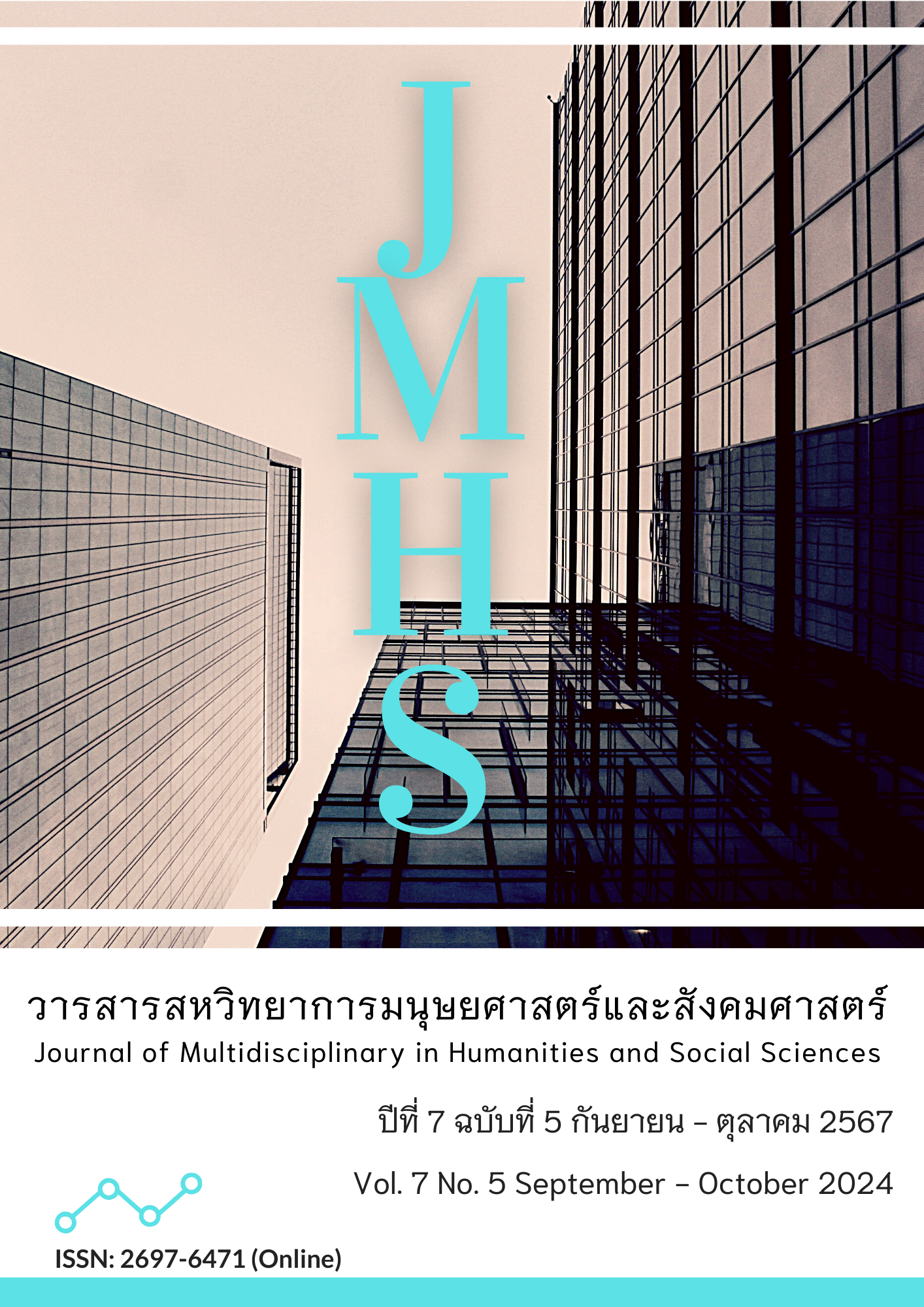Politeness Strategies in Public Speech: A Case of Commencement Speeches in Graduation Ceremonies
Main Article Content
บทคัดย่อ
This study aimed to 1) discover the type of politeness strategies employed in commencement speeches by Taylor Swift and Chadwick Boseman; 2) compare the politeness strategies found in the two commencement speeches; and 3) analyze the use of politeness strategies in the two commencement speeches. The theoretical framework of this study was based on six maxims of politeness strategies, which were proposed by Leech in 1983 and include tact, generosity, approval, modesty, agreement, and sympathy. The commencement speeches by Taylor Swift at New York University in 2022 and Chadwick Boseman at Howard University in 2018 served as the study's data sources. The data were collected from each university's official YouTube and analyzed using textual analysis to determine the type of politeness strategies where the number of maxims was counted and revealed as frequency and percentage. The results were found as follows:
1. Both commencement speeches employed six maxims to ensure successful communication. The generosity maxim was the most frequently applied in Taylor Swift’s speech, while the approval maxim was the most frequently applied in Chadwick Boseman’s speech. Even though they applied different maxims, they had used the same top three maxims: tact, generosity, and approval, respectively.
2. These two influential entertainers applied politeness maxims quite similarly, as their speech aimed to maximize praise to the audience, demonstrate generosity in sharing their experiences, and provide advice to the audience.
3. The difference between the two influential entertainers was the background and the relationship between themselves and the university. Chadwick was an alumnus of Howard University. He had a background with the university, while Taylor had not. Therefore, Chadwick maximized praise from the university and students and showed much gratitude to the lecturers as an alumnus, while Taylor focused on sharing her experiences.
Article Details

อนุญาตภายใต้เงื่อนไข Creative Commons Attribution-NonCommercial-NoDerivatives 4.0 International License.
ทัศนะและความคิดเห็นที่ปรากฏในวารสาร ถือเป็นความรับผิดชอบของผู้เขียนบทความนั้น และไม่ถือเป็นทัศนะและความรับผิดชอบของกองบรรณาธิการ
เอกสารอ้างอิง
Al-Duleimi, H. Y., Rashid, S. M., & Abdullah, A. N. (2016). A critical review of prominent theories of politeness. Journal of Advances in Language and Literary Studies, 7(6), 262-270. https://doi.org/10.7575/aiac.alls.v.7n.6p.262
Ambarita, R., & Mulyadi. (2020). Gender and Language Politeness. European Journal of Applied Linguistics Studies, 2(2), 19-29. https://doi.org/10.5281/zenodo.3685601
Brown, P. (1980). How and why women are more polite. some evidence from a Mayan community. In McConnell-Ginet, S., Borker, R., & Furman, N., Eds. Women and Language in Literature and Society (pp.111-135). New York: Praeger.
Chen, W. (2018). A critical discourse analysis of Donald Trump’s inaugural speech from the perspective of systemic functional Grammar. Journal of Theory and Practice in Language Studies, 8(8), 966-972. http://dx.doi.org/10.17507/tpls.0808.07
Coates, J. (2015). Women, Men and Language: A sociolinguistic account of gender differences in language. (3rd ed.). Routledge. https://doi.org/10.4324/9781315645612
Duangkhot, S. (2017). Politeness at work: Analysis of a job application letter with Leech’s principles of politeness. REFLections, 23, 24–33. https://so05.tci-thaijo.org/index.php/reflections/article/view/210264
Fox, K. (2004). Watching the English, The hidden rules of English behaviour. Hodder & Stoughton. Retrieved from https://edisciplinas.usp.br/pluginfile.php/4434518/mod_resource/content/1/Watching% 20the%20English.pdf
Furkatovna, S. A., Jurabekovna, T. M., & Mamurjonovna, T. P. (2021). Gender aspects of politeness strategy in speech acts. Journal of Linguistics and Culture Review, 5(S2), 1488-1496. https://doi.org/10.21744/lingcure.v5nS2.1962
Hadi, A. (2012). A critical appraisal of Grice’s cooperative principle. Open Journal of Modern Linguistics, 3(1), 69-72. http://dx.doi.org/10.4236/ojml.2013.31008
Howard University. (2018, May 14). Chadwick Boseman's Howard University 2018 commencement speech [Video]. YouTube. Retrieved June 30, 2023, from https://www.youtube.com/watch?v=RIHZypMyQ2s
Inner Development Goals. (n.d.). IDG framework. Retrieved June 30, 2023, from https://www.innerdevelopmentgoals.org/framework
Jie, W., & Feifei, W. (2016). The application of politeness principle in the analysis of drama: Take teahouse as an example. Journal of Cross-Cultural Communication, 12(5), 35-38. https://doi.org/10.3968/8376
Kraisriwattana, J., & Poonpon, K. (2020). A discourse analysis of speech structure from TED talks corpus. KKU Research Journal of Humanities and Social Sciences (Graduate Studies), 9(2), 59-72. https://so04.tci-thaijo.org/index.php/gskkuhs/article/view/241408
Leech, G. (1983). Principles of pragmatics. Longman Linguistics Library. Retrieved from https://www.scribd.com/doc/242418276/Principles-of-pragmatics-Leech
Mariani, P. E. (2019). Politeness principles in “Donald Trump’s election victory speech. Jurnal Humanis, Fakultas Ilmu Budaya Unud, 23(2), 95-100. https://doi.org/10.24843/JH.2019. v23.i02.p03
New York University. (2022, May 18). NYU's 2022 commencement speaker Taylor Swift. YouTube. Retrieved April 30, 2023, from https://www.youtube.com/watch?v=OBG50ao UwlI&t=2s
Pardede, H., Herman, & Pratiwi, W. (2019). An analysis of politeness principle maxims found in big hero 6 movie. European Exploratory Scientific Journal, 3(4), 1-7. https://syniutajournals.com/index.php/EESJ/article/view/87
Pfister, J. (2010). Is there a need for a maxim of politeness?. Journal of Pragmatics, 42, 1266-1282. https://doi.org/10.1016/j.pragma.2009.09.001
Qodirberganovna, N. A. (2020). Politeness as a system of communicative strategies. International Journal of Engineering and Information Systems, 4(10), 93-95. http://ijeais.org/wp-content/uploads/2020/10/IJEAIS201024.pdf
Ryabova, M. (2015). Politeness Strategy in Everyday Communication. Procedia - Social and Behavioral Sciences, 206, 90-95. https://doi.org/10.1016/j.sbspro.2015.10.033
Shahrokhi, M., & Bidabadi, F., H. (2013). An overview of politeness theories: current status, future orientations. American Journal of Linguistics, 2(2), 17-27. https://doi.org/10.5923/j.linguistics.20130202.02
Tejarajanya, B. (2016). A comparative study of compliment responses among Thai and Japanese speakers. Journal of Language and Culture, 35(1), 47-80. https://so03.tci-thaijo.org/index.php/JLC/article/view/240493
Xia, X. (2013). Gender differences in using language. Theory and Practice in Language Studies, 3(8), 1485-1489. https://doi.org/10.4304/tpls.3.8.1485-1489
Yu, H., & Ren, C. (2013). Politeness principle in human communication. Studies in Sociology of Science, 4(3), 54-57. http://dx.doi.org/10.3968/j.sss.1923018420130403.H405
Zheng, S. (2015). Students’ Politeness to Lecturers in WhatsApp Application Measured Using Leech Maxim. Theory and Practice in Language Studies, 5(7), 1467-1475. http://dx.doi.org/10.17507/tpls.0507.20


